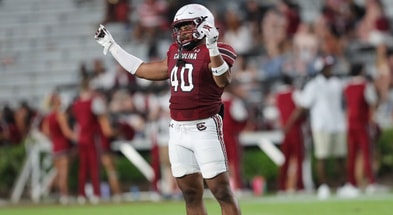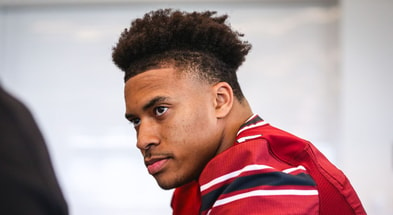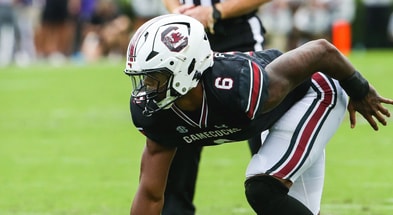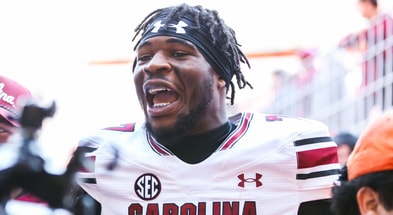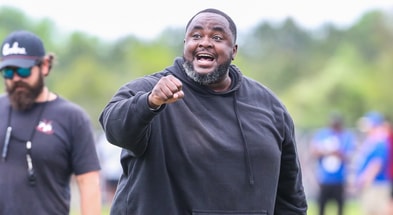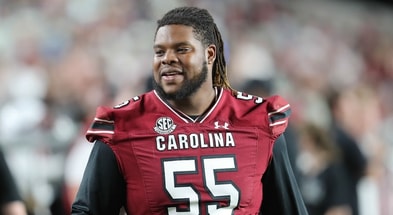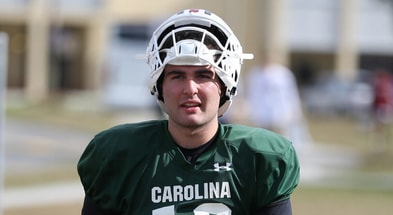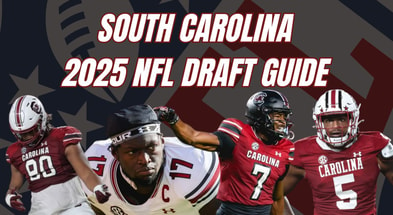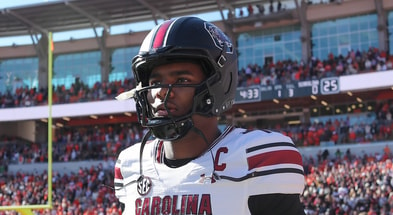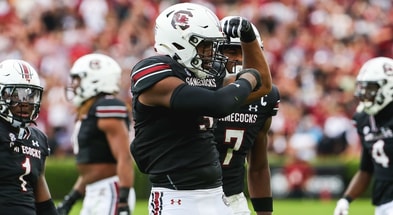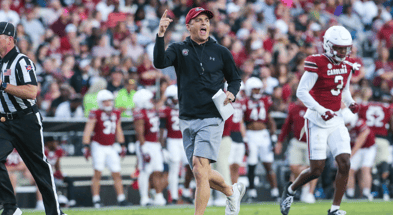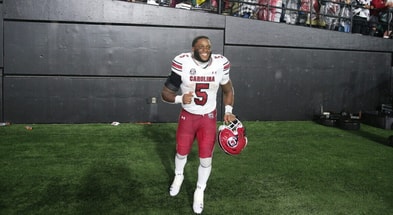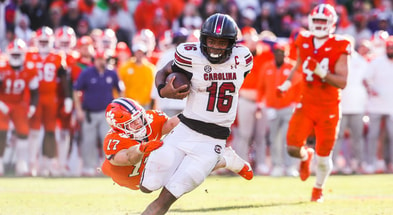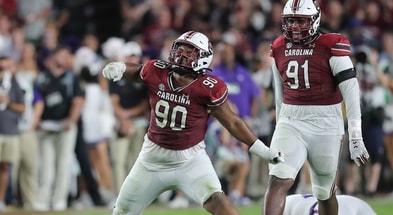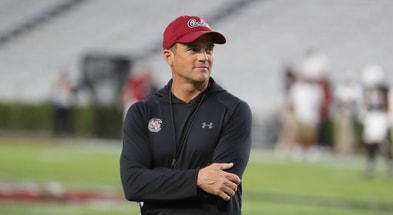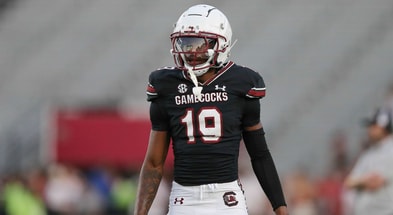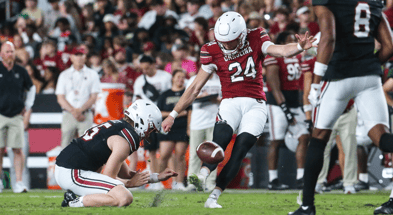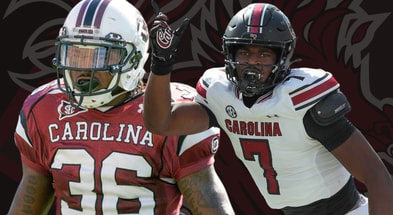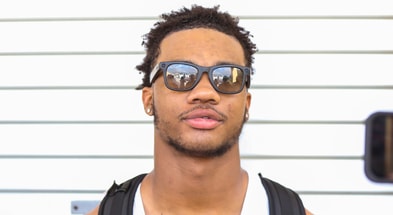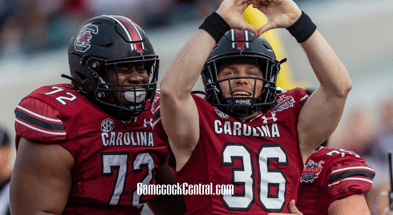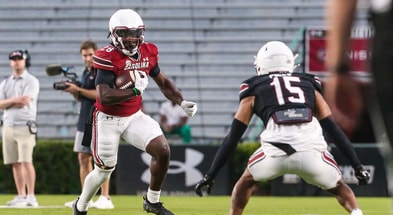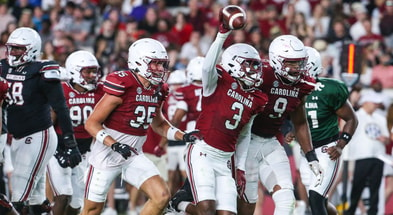1984: Fire Ants and Black Magic turn 40

(The following piece contains an excerpt from A Gamecock Odyssey: University of South Carolina Sports in the Independent Era, published by USC Press. Take advantage of the USC Press holiday sale, good for 50% off on “Odyssey” and their entire catalog of titles through December 31 by using promo code JHOL24 at checkout.)
Following a dream-shattering loss to Navy, Carolina recaptured its mojo with a magical win at Clemson to salvage a then program-best 10th win.
Forty years ago this November, Gamecock football fans breathed rarified air. Under second-year head coach Joe Morrison, South Carolina bolted to a 9-0 start (still the best start in program history) and found itself ranked #2 in the Associated Press (AP) poll. Along the way, Carolina defeated old nemesis Georgia, legendary Notre Dame in South Bend, and powerhouse Florida State in the first-ever nationally-televised game at Williams-Brice Stadium.
The team captured fans’ collective imagination, not just with the winning, though that certainly helped, but with all the quirky things that make college football so much fun.
There was the “Fire Ant” defense – named for Carolina’s swarming, aggressive style of play and the all-garnet home uniforms that became standard in those days. “They look like a bunch of fire ants,” defensive coordinator Tom Gadd said while watching game film. When Morrison mentioned Gadd’s comment to reporters, the nickname stuck.
“Black Magic” – an homage to Morrison, who stalked the sidelines and practice fields behind mirror aviators, clad in all-black (and furtively puffing Marlboros). Stores began carrying Gamecock gear in black in addition to the traditional garnet, and fans snapped it up. When Carolina upset visiting Southern Cal in 1983 – Morrison’s first season – it felt cathartic to fans after the turmoil and mediocrity of 1981 and ‘82 – Jim Carlen’s drama-filled final season and Richard Bell’s one-year experiment, respectively.
Morrison brought a swagger that the program had been missing, or more accurately, never had. Born of his rough-and-tumble 14-year career as a player with the NFL’s New York Giants, he imbued the team and its fans with that confidence. And when the wins started piling up in 1984, it was a magical ride indeed.
When Carolina, 8-0 and ranked #5, faced #11 Florida State on Nov. 10, it was before a national audience – ABC’s game of the week – with college football royalty Keith Jackson calling the game. It was a spectacle, and the Gamecocks delivered. Sparked by seven defensive takeaways and Raynard Brown’s kickoff return for a touchdown to open the second half, Carolina won 38-26 in a game that didn’t feel that close.
After Gamecock touchdowns, of which there were many that evening, fans threw oranges on the field, symbolic of an anticipated invitation to the Orange Bowl for a shot at the national championship. After rivals Clemson and Georgia had won those programs’ first national championships to cap the 1981 and ‘80 seasons, respectively, it was an opportunity Gamecock fans coveted deep in their bones.
Bowl invitations often went out early in those days – sometimes before the final game of the regular season. Most pundits believed if the Gamecocks won their next game to go 10-0, they would receive an Orange Bowl bid. Regardless of what happened in Carolina’s traditional season-ender versus Clemson, the prize was within reach. Take care of business in Week 10, and the Gamecocks would be Miami-bound.
A 3-5-1 Navy squad was all that lay between South Carolina and the promised land.
The Midshipmen were riddled by injuries in 1984, most notably losing their all-America tailback Napoleon McCallum to a broken leg. The week before Carolina’s visit, their starting quarterback, Bill Byrne, went down with a broken leg of his own. Morrison warned, though, the Navy squad would be “ready emotionally and mentally” for the Gamecocks and maintained that Carolina would need to play perhaps a better game than they had against FSU.
It was coach-speak, and few took him seriously. And who could blame players and fans for looking beyond? Talk of a Nebraska versus South Carolina national championship matchup dominated college football media. Moreover, not a single player on the Gamecock roster had tasted victory over archrival Clemson, with Carolina’s last win in the series coming in 1979. With the Tigers waiting in the wings a week later, thoughts turned naturally to bigger stages and brighter lights beyond Annapolis.
Sunk
There are certain maritime disasters that naturally come to mind when pondering the 1984 USC-Navy game. A sinking of the “unsinkable” in the cold, unforgiving waters of the North Atlantic, perhaps, or in this case, the Chesapeake Bay. It remains the single most haunting loss in the long, often fraught history of Gamecock football.
Forty years later, the “what-if” conversations ebb and flow like Lowcountry tides, filling the pluff mud channels and fecund estuaries of fan message boards with revisionist histories written on the fly but pondered over decades.
A single word, coldly sinister in the context of South Carolina athletics, has come to embody the myriad cruel plot twists that have bedeviled Gamecock fans through the years. For us, it is the ultimate four-letter word… NAVY.
It was sunny and cold, with highs in the mid-forties and a bracing northern wind when the #2-ranked Gamecocks and Midshipmen took the field at 34,000-seat Navy-Marine Corps Stadium in Annapolis. A smattering of garnet-clad South Carolina fans made the trip and sat among a sea of Navy blue and gold, both local fans and the brigade of midshipmen in their wool peacoats and crisp Academy uniforms.
It was a near-perfect day for football.
The scrappy Midshipmen proved up to the task, playing spirited football and outplaying Carolina from the start. Navy built a 14-7 lead by halftime. A disastrous third quarter followed, in which it was injury-plagued Navy who looked like the top-five team. By the start of the fourth quarter, they had built a commanding 31-7 lead and scored again two plays later, capping a 7-play, 78-yard drive to make it 38-7.
The game and Carolina’s dream of a national championship were all but over. Each time Navy scored, members of the brigade of midshipmen poured out of the stands behind the north end zone to do pushups corresponding to their point total. They got quite a workout that afternoon.
The Gamecocks scored two touchdowns in the fourth quarter to pull to 38-21, but that was as close as it got, with turnovers and a ticking clock killing any hopes of another miracle comeback in a season full of dramatic come-from-behind finishes. The 14-point underdog Midshipmen had beaten the country’s second-ranked team by seventeen points. It was perhaps the greatest college football upset in the decade of the 80’s.
Gamecock letterman Eric Poole, a junior wide receiver on that ‘84 team, recalls, “As much as we said we weren’t looking ahead to Clemson, we probably were. In the back of too many of our minds, I think we were thinking, ‘we’ll just cruise through this and then go play Clemson,’ and Navy just absolutely took us to the woodshed.”
To compound the Gamecocks’ disappointment, news came while boarding the flight home that Oklahoma had upset top-ranked Nebraska 17-7 that afternoon. Had Carolina taken care of business in Annapolis, they would have achieved the #1 ranking for the first time in program history. It was a gut punch, a twist of the knife, salt in the wound. Pick your cliche – it hurt.
Jim Walsh, a senior left guard in ‘84 said, “After the ballgame… it was devastating. We knew what was at stake.”
In spite of the loss, an estimated 5,000 fans gathered to great a beleaguered Gamecock team at the Columbia Airport. Coach Joe Morrison told the gathered crowd, “Coming home after the Notre Dame game (a thrilling 36-32 Gamecock win), it was good to see the fans here. This means a lot more.”
A pall over the Capital City
Indeed, the Gamecocks dropped seven spots in the AP poll to #9. Undefeated Brigham Young, which had been behind Carolina at #3 the prior week, surged to the top spot. Oklahoma moved from #6 to #2 on the strength of its upset of previous #1 Nebraska, while Oklahoma State and Florida each moved up one spot to third and fourth, respectively. Washington, which had been #1 two weeks earlier, rounded out the new top five.
Despite the good feelings at the Columbia airport following the Navy game, a pall hung over the Capital City during the week leading up to Carolina’s regular-season finale at Clemson.
Already talk about what could have been dominated conversations as businesspeople, politicians, students, and fans met to commiserate in hushed, reflective tones over breakfast at the Capitol Restaurant and the Elite Epicurean downtown, or the Lizard’s Thicket on Beltline Boulevard or Two Notch Road.
All over Columbia, the stages of grief found people in various states of denial, bargaining, anger, depression, and acceptance. Monday was dark and funereal. By Thursday, as families gathered for the annual Thanksgiving feast, thoughts turned ever so slightly away from the disappointment of Navy and to the many milestones the ‘84 Gamecocks had achieved.
By Friday, thoughts turned to Clemson as students and fans gathered on campus for the annual Tiger Burn. The ritual burning of a giant papier mache tiger that year doubled as a funeral pyre of sorts, an opportunity to collectively grieve and release whatever national championship hopes they may have harbored just a few short days before.
As the glowing embers floated skyward on that chilly November evening, dancing among autumn leaves and the brass notes of the marching band, healing and perspective took hold. There was still much to play for: a state championship; a 10th (and perhaps 11th) win was still in reach; the first win over Clemson since 1979, and the first win at Clemson since 1970; and a yet-to-be-named bowl destination. Not the Orange Bowl, perhaps, but a good one nonetheless, and only the sixth bowl berth in program history.
Hold that Tiger
South Carolina wasn’t the only team coming off a humiliating defeat in the state of Maryland. Thirty miles north of Annapolis, the Tigers took a thumping from the Maryland Terrapins to the tune of 41-23 at Memorial Stadium in Baltimore. Clemson was 7-3 entering the season finale and serving the last of their three-year probationary period – a result of NCAA sanctions over recruiting violations from their championship season of 1981. Even with Carolina’s 9-1 record and a Top-10 ranking, oddsmakers set Clemson as a two-point favorite, owing largely to trends in the rivalry and home-field advantage for the Tigers.
Clemson carried a 25-game home winning streak into the contest. Its seniors had never tasted defeat at home or to their arch-rivals from Columbia. Moreover, the Tigers were 10-0 in orange britches, which they reserved for big games, and had debuted against the Gamecocks in 1980. The Tigers ran down the hill that day in all-orange after clandestine pregame warmups in nearby Littlejohn Coliseum, which Gamecock historian Tom Price called a “psychological ploy” on the part of Clemson coach Danny Ford.
Another psychological ploy, according to Price in his book, The ‘84 Gamecocks, was the Clemson band’s playing of “Anchors Aweigh,” the Navy fight song, to needle Gamecock players and fans about the prior week’s loss. Clemson fans threw oranges on the field, mocking Gamecock fans who had done the same during Carolina’s win over FSU. Mixed with the oranges were several lemons. One fan carried a sign taunting, “Welcome to your Orange Bowl, South Carolina.”
Top 10
- 1Breaking
MiLaysia Fulwiley
South Carolina transfer to LSU
- 2Hot
2nd Round NFL Mock Draft
QBs under microscope
- 3
Shedeur Sanders reacts
To going undrafted in 1st round
- 4
Marcus Spears fires back
At Stephen A. Smith over Shedeur take
- 5
Picks by conference
SEC, Big Ten dominate NFL Draft
Get the On3 Top 10 to your inbox every morning
By clicking "Subscribe to Newsletter", I agree to On3's Privacy Notice, Terms, and use of my personal information described therein.
The Gamecocks took the field in visiting white jerseys and, in a surprise to many, black britches. They had lost versus Clemson in all-black uniforms the prior year and struggled mightily versus The Citadel in black jerseys during the season-opener. Most assumed black had been shelved for good in favor of the traditional garnet. If it was an unsettling omen to the 12,000 Gamecock fans scattered around 80,500-seat Memorial Stadium, Carolina’s first-half performance did little to comfort them.
Carolina trailed 21-3 in the second quarter and 21-10 at the half. In the third quarter, Tony Guyton caught Clemson quarterback Mike Eppley in the end zone for a safety, closing the score to 21-12. Placekicker Scott Hagler missed a 40-yard field goal attempt on Carolina’s ensuing possession, and the score remained 21-12 entering the final period.
Hagler connected on a 41-yard field goal early in the fourth, bringing the Gamecocks to within 6 points, 21-15. Building on the momentum generated by Carolina’s late-second-quarter touchdown, the Fire Ant defense held Clemson to just one first down in the third period, sacking Eppley for the safety and securing a Bryant Gilliard interception. Though still trailing, the Gamecocks were surging, and Clemson fans could only watch the clock in its agonizingly slow countdown.
When the Gamecock defense forced a Clemson punt with just over three minutes left, Carolina took possession at their 14-yard-line. 86 yards from pay dirt.
On third-and-6, quarterback Mike Hold, who had started for the first time all season, hit receiver Chris Wade, who weaved his way along the right sideline for a 36-yard gain, keeping the drive alive just inside Clemson territory. Tailback duo Quinton Lewis and Thomas Dendy carried for 16 yards and 18 yards, respectively, and the Gamecocks were in business, first-and-10 at the Clemson 11-yard-line.
Two Hold keepers picked up 9 additional yards, and a Clemson face mask penalty gave Carolina a first-and-goal at the Tiger 1. Hold kept once again off right tackle, breaking the plane of the goal line for a Carolina score, knotting it at 21.
54 seconds remaining.
Hagler trotted onto the field, having connected on 42 consecutive point-after attempts, one shy of the school record. Just as the ball was snapped, yellow flags flew, and Hagler, following through with the kick, missed left. The Clemson crowd roared, but the penalty soon became obvious. Dead ball penalty – 12 men on the field for the Tigers.
Do-over.
Hagler lined up for his mulligan, and this time the kick was true, giving Carolina a 22-21 lead, its first of the day. Gamecock special teams executed the kickoff brilliantly, as Jay Frye, the grandson of USC’s legendary groundskeeper Sarge Frye, tackled Clemson’s Ray Williams at the 8-yard-line, putting the Tigers 60 yards away from realistic field goal range.
Clemson’s Eppley completed 1 of 6 passes for 22 yards to the Tiger 30, but a fourth-down pass dropped harmlessly beyond its intended target. Carolina took possession, needing only to take a knee as the clock expired.
As Hold took the snap and backed-peddled, Clemson’s behemoth lineman, William “Refrigerator” Perry – a near 400-pounder – burst through the line like an agitated grizzly. As the clock hit zeroes, Hold dropped the ball at Perry’s feet with dramatic flourish – an iconic scene etched in the long, colorful history of the rivalry.
The Memorial Stadium scoreboard went dark within seconds of time elapsing, but the impotent gesture meant little to joyful Gamecock players and fans who lingered to celebrate in the late afternoon shadows of Death Valley.
Sweet redemption.
Following the game, coach Joe Morrison and Athletics Director Bob Marcum accepted the official Gator Bowl invitation amidst the din of a jubilant visitor’s locker room. The man tasked with extending the invitation? President of the Gator Bowl, J.T. Hill, a 1949 Clemson alumnus. Tiger loyalties aside in his professional role, Hill told the gathered media, “We’re very pleased about having South Carolina.”
The Gamecocks received a hero’s welcome from more than 6,000 fans as the team busses arrived at the Roost athletic dorms that evening.
Though Jacksonville was well north of the Florida destination the Gamecocks had hoped for, players and fans looked eagerly to post-season play in a Dec. 28 matchup with the #3-ranked Oklahoma State Cowboys.
The legacy of ‘84
Despite a spirited 21-14 loss to the Cowboys from Stillwater, Oklahoma, the legacy of those 1984 Gamecocks is undiminished some forty years on.
Walsh described what it meant to be a part of that team, “It was really special. It was a year nobody expected us to do what we did.”
For those who lived it, 1984 is bronze-cast – perhaps even more special in some ways than Spurrier’s great run decades later because of its unexpected “lightning in a bottle” nature, and because it was the first Gamecock team to succeed at that level.
Morrison, speaking from the USC locker room following the Gator Bowl said, “Both teams can be proud of this one. And there are some things learned from tonight’s game that will go with these young men later in life. I’m still proud of our players’ accomplishments.”
All-American linebacker James Seawright told reporters, “This is not the way we [the seniors] wanted to go out, but I think we accomplished something. We came here to start a tradition, and we did. We can say that we are the best Carolina team ever.”
The Gamecocks finished just outside the Top 10, at #11 in the final Associated Press poll, the highest finish in program history at the time. Carolina made a lot of history during that most magical of seasons. Fans spent the off-season reflecting on the thrilling and unexpected ride of 1984 – the exploits, the upsets, the personalities, and the unbridled joy shared by so many.
The future was bright. Anything seemed possible.

